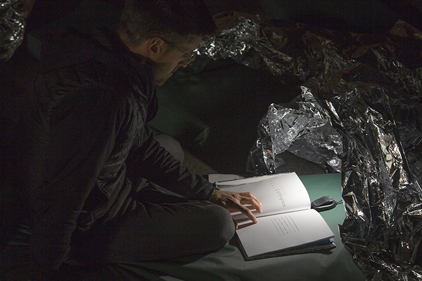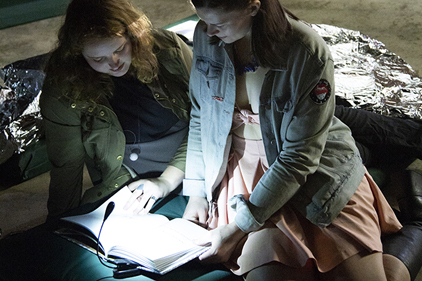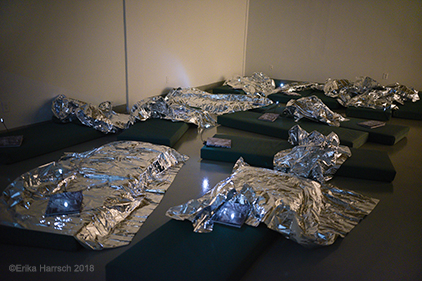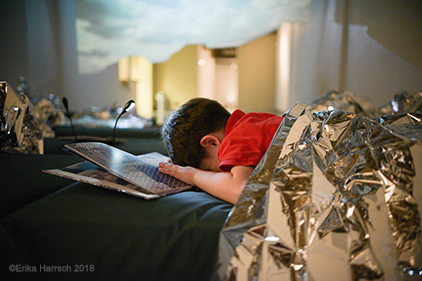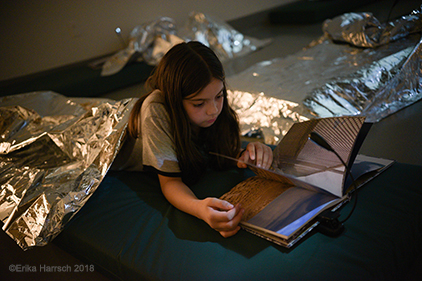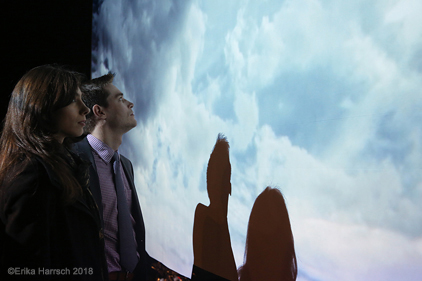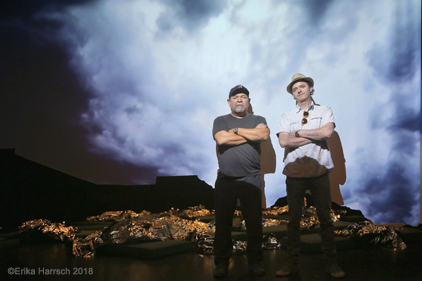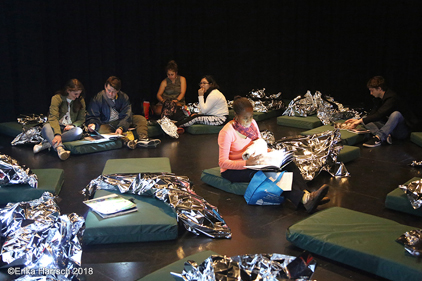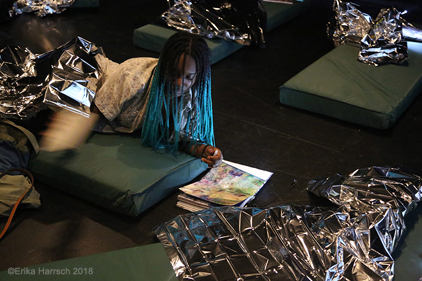"Under the Same Sky… We Dream” Has been exhibited at BRIC Arts - Media House, Brooklyn, NY, April - May 2018, at the B3 Frankfurt Biennale for the Moving Image, December 2017 and at the Rubin Center for the Visual Arts at UTEP, El Paso, TX Aug - Sept 2017
Under the Same Sky…We Dream
By Erika Harrsch in collaboration with singer Magos Herrera This video-sound installation is an homage to the children who try to cross borders to start a new life with or without their parents, and to all immigrants who dream of a future with better opportunities and a safer life. Under the same sky... we dream reflects on the right to move freely beyond borders and the consequences of unregulated migration, the detention centers for undocumented minors and the Dream Act legislation for immigration reform in the United States. This installation is a multi-sensory perspective on the fraught realities at the southern border of the USA and the immigration conundrum. The border, undergoing constant construction and revision, is a living-sketch transforming upon political interests and national structures, increasing strategies for defining territories, and opposition to global mobility. Since the beginning of 2014, hundreds of thousands of undocumented families and unaccompanied children from Central America and Mexico have arrived at the Mexico-USA border, lacking any humanitarian protections during their journey. As a result of the criminalization of undocumented migration to the USA, this human crisis has turned into a multimillion dollar business for private prisons and county jails. The corporate system of mass incarceration holds ninety percent of immigration detainees, which has enabled private companies to greatly increase their profits on the adversity of undocumented families and innocent asylum seekers. Under the same sky... we dream, takes place in a dim room divided in two by a screen with a video projection, visible from both sides, showing a time lapse of the sky from dawn to sunset. The suspended screen is cut to the contours of the USA-Mexico borderline. The video has been created from more than 35,000 photographs, representing the sky and the clouds that cross above the fence at the border between El Paso and Juarez. On the other side of the room, there are mattresses and mylar refugee blankets on the floor, the kind found in Immigration and Customs Enforcement (ICE) detention centers. In a participatory experience, the public is invited to interact with the space and the silver blankets dispersed on the floor, to sit or lie on a mattress, in an act of solidarity with the incarcerated immigrant minors. The elements that compose the piece evoke the relativity of the physical space and territories, delimited by artificial geopolitical borders, although under the same sky. Within this thought-provoking and symbolic representation of a holding cell at a U.S. Customs and Border Protection processing facility, a captivating song is also heard. The evocative voice tapestry that surrounds the space is a sung version of the Dream Act reform legislation that was never adopted. The song is conceived with phrases extracted directly from the 2011 Dream Act Bill of Congress. The melodic rendition is by Mexican singer Magos Herrera. The fourteen-minute song has an inviting, hopeful, and warm tone, in contrast to the dry, categorical, and authoritative nature of the legal words that compose the lyrics. The embracing quality of Herrera's voice transforms the words into a song of hope like one from a mother to her lost child. It addresses the children left behind by forced migration, the ones that have departed alone to another country, or the ones who were victims of the family separation policy. On top of each floor mattress there is an illuminated book with clip lanterns. The artist book titled Dream Book that includes word by word the Dream Act. The text is arranged in the style of concrete or visual poetry, and distributed through the pages with the cadence of the sung version. The visitors can watch the video and follow the printed song in the book, while surrounded by photographic documentation of the border over a period of four years. The contemplative video with its endless lapsing clouds brings to mind the dormant state of immigration reform, a resolution which could have normalized the status and reshaped the lives of millions of Dreamers. So many lives, aspirations, and opportunities are lost in endless congressional bickering, personal squabbles among legislators who forget that real lives are at stake and the hope of innocent human beings to one day see their dreams of a regulated status come true. - Erika Harrsch The Dream Act is a bipartisan bill first introduced in congress in 2001. Known formally as Development, Relief, and Education for Alien Minors, it has since been reintroduced several times, but has failed to pass. This bill aimed to create a pathway to citizenship for undocumented children who grew up in the United States, a multi-phase process that would have granted conditional residency and, after candidates met further qualifications, permanent residency. Since 2012, the Deferred Action for Childhood Arrivals (DACA) program has provided a two-year renewable reprieve from deportation as well as eligibility for work authorization to more than 750,000 unauthorized immigrants brought to the United States as children. What will happen to these so-called Dreamers is unclear, considering the policy of the newly elected president of the United States. A 2017 executive order called for the construction of a southern border wall and instructed Immigration and Customs Enforcement to expand its sprawling network of immigration detention centers together with privately owned prisons. It also called for raising the number of immigrants that ICE incarcerates daily, nationwide.
Under the Same Sky…We Dream at the Rubin Center for the Visual Arts
The Rubin Center for the Visual Arts is located on the campus of The University of Texas at El Paso (UTEP), a uniquely bilingual, bi-cultural and bi-national campus less than a quarter mile from the U.S.-Mexico border. Our student body is 80% Hispanic with an additional 5% or more who cross over daily from our neighboring city, Ciudad Juárez. Issues of immigration, educational access and the relationship between the nations of Mexico and the United States are not just political topics or theoretical conversations here, they form the very fabric of who we are as a border community, which is precisely why we are excited and honored to host Erika Harrsch’s new project Under the Same Sky…We Dream, a multi-media installation by the artist in collaboration with internationally acclaimed Mexican singer Magos Herrera.
The installation by Harrsch takes place in a darkened room which is separated by a time-lapse video projection of the sky, visible from both sides of the hanging screen, and sculpted to the contours of the US-Mexico borderline. Visitors will pass under the screen where they will encounter a series of military-style mattresses and mylar blankets, exactly like those used by Immigration and Customs Enforcement (ICE) in detention centers used to house undocumented minors who have been caught trying to enter the country illegally. Audience members are invited to sit or lie on one of these mattresses as an act of reflection and solidarity. From their seat on the gallery floor they can observe the subtle changes in the video sky which compresses more than thirty thousand still photographs from sunrise to sunset, a metaphor for both travel and the passing of time in an immigrant’s journey. Visitors are simultaneously surrounded by Magos Herrera’s musical rendition of the DREAM Act, projected in stereo into the gallery space, and can use tiny personal clip lights to follow along in artist books that contain the words of the DREAM act superimposed on top of images of border fences, passing clouds, desert landscapes and immigrant detention centers.
While there are no precise statistics available to document the number of UTEP students who would be affected by the passage of some version of the DREAM Act, what we do know about our student body and the surrounding community is that many of them come from mixed-document families and all of them are living out different versions of the American Dream. We have students who are children of farmworkers, and who may have been brought here as children themselves; students who have earned their legal status through service in the military; students who were born here but who have undocumented parents or siblings that live in constant fear of deportation. The core question that the DREAM Act seeks to address – how do we ensure the security, safety and economic future of accomplished and long-standing members of our community, regardless of their place of birth? – is a question that has a particular relevance in this place and at this time in our nation’s history. Core to the Rubin Center’s mission is a commitment to using contemporary art as a springboard for deeper conversations about the world around us. Erika Harrsch’s Under the Same Sky…We Dream will be central to fulfilling that mission in the months ahead.
Kerry Doyle, Director and Chief Curator
Rubin Center for the Visual Arts
The University of Texas at El Paso




